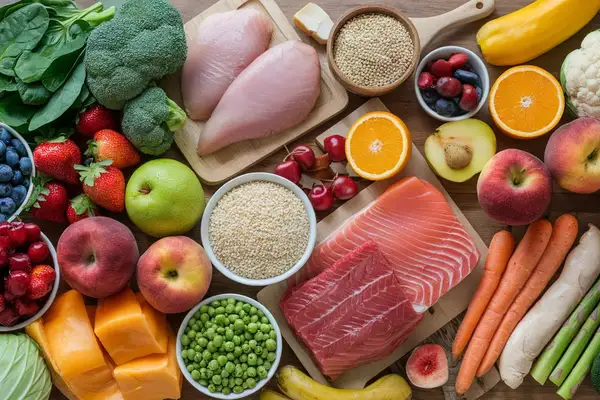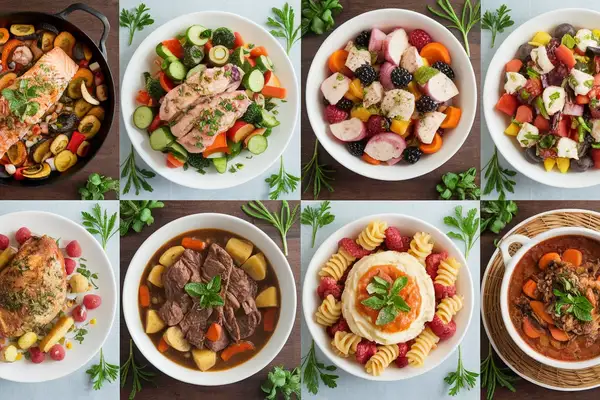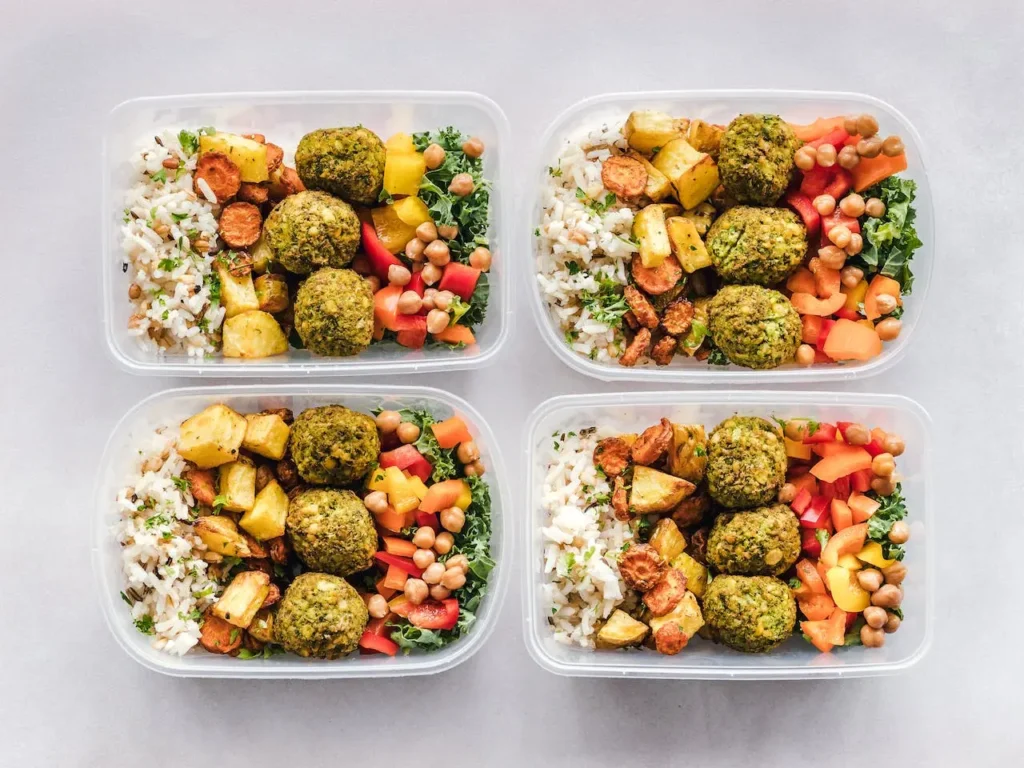7-Day Diet Plan For High Blood Pressure
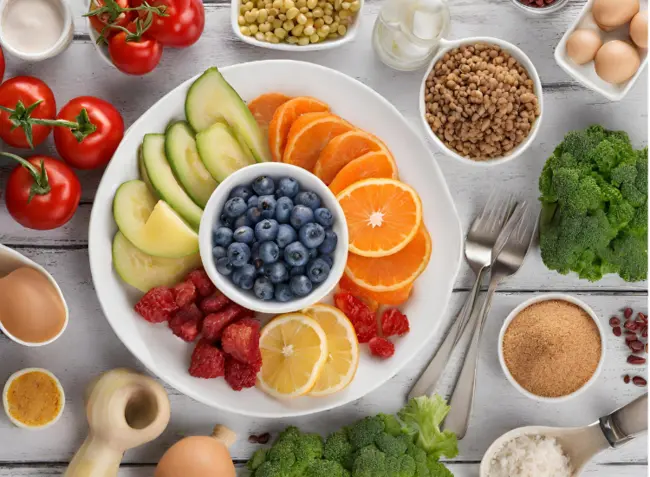
This post may contain affiliate links, meaning I may earn a commission if you make a purchase, at no extra cost to you. I only recommend products I trust. Thank you for your support.
High blood pressure, also known as hypertension, is a condition in which the force of blood against the walls of your arteries is consistently too high.
This can lead to serious health problems such as heart disease, stroke, and kidney disease.
A high blood pressure diet, commonly referred to as the DASH (Dietary Approaches to Stop Hypertension) diet, focuses on consuming nutrient-dense, low-sodium, heart-healthy foods that help manage and reduce high blood pressure (hypertension).
Diet plays a crucial role in managing high blood pressure. Certain foods can raise your blood pressure, while others can help lower it.
This comprehensive 7 day diet plan for high blood pressure aims to provide you with a variety of delicious and heart-healthy meals to support your journey towards better blood pressure management.
7-Day Diet Plan for High Blood Pressure
This 7-day diet plan for high blood pressure features potassium rich foods, magnesium rich foods, and low sodium foods that support cardiovascular health and lower blood pressure naturally.
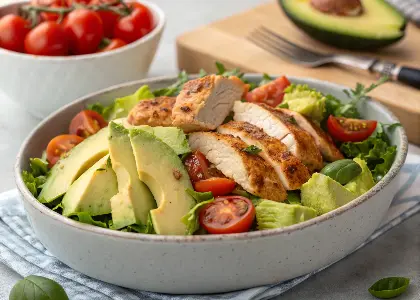
Day 1
Breakfast:
- Oatmeal with Banana & Chia: A fiber-rich, energizing breakfast to support digestion and heart health. (1 cup cooked oatmeal, 1 medium banana, 1 tbsp chia seeds)
Lunch:
- Grilled Chicken Salad: A lean protein-packed lunch with hydrating veggies and a light vinaigrette. (4 oz grilled chicken, 2 cups mixed greens, ½ cup cherry tomatoes, ½ cucumber, 2 tbsp vinaigrette)
Dinner:
- Baked Salmon with Quinoa & Asparagus: Omega-3-rich salmon with fiber and antioxidants for a balanced dinner. (6 oz baked salmon, ½ cup quinoa, 1 cup steamed asparagus)
Snacks:
- Greek Yogurt with Berries: A refreshing, protein-rich snack with natural sweetness and antioxidants. (1 cup Greek yogurt, ½ cup fresh berries)

Day 2
Breakfast:
- Avocado Toast with Poached Egg: A heart-healthy, fiber-rich breakfast with healthy fats and protein. (2 slices whole grain bread, ½ avocado, 1 poached egg)
Lunch:
- Cranberry Lentil Soup: A tangy, heart-healthy soup rich in fiber and antioxidants, made with lentils, cranberries, and herbs. (½ cup lentils, ¼ cup dried cranberries, 2 cups low-sodium vegetable broth, 1 clove garlic, ½ tsp thyme, 1 tbsp olive oil)
Dinner
- Grilled Shrimp with Brown Rice & Roasted Veggies: A lean protein dinner with complex carbs and colorful antioxidants. (5 oz grilled shrimp, ½ cup brown rice, 1½ cups roasted vegetables)
Snacks:
- Unsalted Mixed Nuts: A simple, heart-healthy snack rich in healthy fats and plant protein. (¼ cup unsalted almonds, walnuts, pistachios)

Day 3
Breakfast:
- Green Smoothie: A refreshing, nutrient-packed breakfast smoothie loaded with fiber, potassium, and antioxidants. (2 cups spinach & kale, 1 medium banana, 1 cup unsweetened almond milk)
Lunch:
- Turkey Avocado Wrap: A protein-rich, heart-healthy lunch with whole grains and healthy fats. (4 oz turkey, ¼ avocado, 1 whole grain tortilla, lettuce, tomato)
Dinner:
- Baked Chicken Thighs with Sweet Potato & Green Beans: A balanced, comforting dinner rich in lean protein and complex carbs. (6 oz baked chicken thighs, 1 medium sweet potato, 1 cup steamed green beans)
Snacks:
- Apple with Almond Butter: A fiber-rich, satisfying snack with natural sweetness and healthy fats. (1 medium apple, 1 tbsp natural almond butter)

Day 4
Breakfast:
- Greek Yogurt Parfait: A creamy, protein-packed breakfast with low-sugar granola and fresh berries for a sweet start. (1 cup Greek yogurt, ¼ cup low-sugar granola, ½ cup fresh berries)
Lunch:
- Quinoa Salad: A refreshing, fiber-rich salad with cucumbers, cherry tomatoes, and a tangy lemon vinaigrette. (1½ cups quinoa salad with diced cucumbers, cherry tomatoes, lemon vinaigrette)
Dinner:
- Baked Salmon with Sautéed Kale: A nutrient-dense dinner packed with omega-3s and vitamins. (6 oz baked salmon, sautéed kale)
Snacks:
- Carrot Sticks with Hummus: A crunchy, satisfying snack with fiber and healthy fats. (1 cup carrot sticks, 2 tbsp hummus)
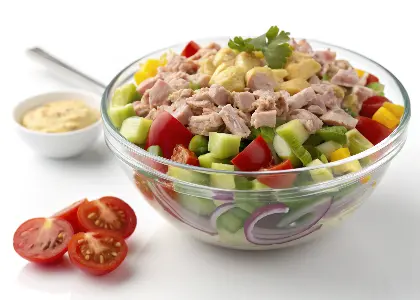
Day 5
Breakfast:
- Scrambled Eggs with Spinach: A protein-packed breakfast with fiber-rich spinach and whole grain toast. (2 eggs, 1 cup spinach, 2 slices whole grain toast)
Lunch:
- Tuna Salad: A light yet satisfying meal with canned tuna, mixed greens, and a tangy balsamic vinaigrette. (5 oz canned tuna, 2 cups mixed greens, 2 tbsp balsamic vinaigrette)
Dinner:
- Turkey Chili: A hearty and flavorful turkey chili with kidney beans, served with steamed green beans for a balanced meal. (1½ cups turkey chili, 1 cup steamed green beans)
Snacks:
- Plain Popcorn: A light, crunchy snack to satisfy your cravings without extra calories. (2 cups plain popcorn, unsalted, unbuttered)
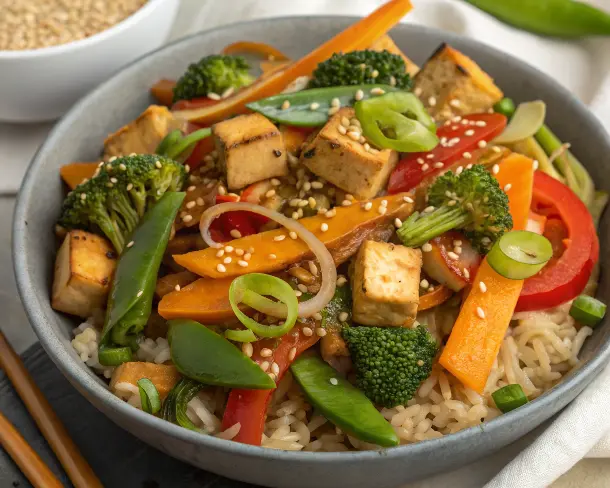
Day 6
Breakfast:
- Carrot Soup: A creamy, nutrient-packed soup made with fresh carrots and aromatic spices. (2 cups carrots, 1 small onion, 2 cups vegetable broth, 1 tsp ginger, ½ tsp cumin, 1 tbsp olive oil)
Lunch:
- Spinach and Chicken Salad: A fresh and protein-rich salad with grilled chicken, spinach, and cherry tomatoes, drizzled with a light vinaigrette. (4 oz grilled chicken, 2 cups spinach, ½ cup cherry tomatoes, 2 tbsp vinaigrette)
Dinner:
- Baked Tofu with Stir-Fried Vegetables: A wholesome dish of baked tofu paired with stir-fried vegetables and brown rice for a complete, satisfying meal. (6 oz baked tofu, 1 cup stir-fried vegetables (bell peppers, snap peas, carrots), ½ cup brown rice)
Snacks:
- Edamame: Protein-rich soybeans, perfect for satisfying hunger while supporting heart health. (1 cup steamed edamame, unsalted)
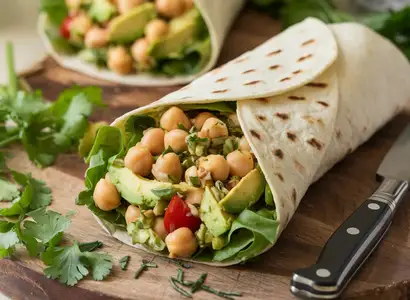
Day 7
Breakfast:
- Overnight Oats with Almond Milk: A creamy and nutritious breakfast made with oats, almond milk, sliced almonds, and sweet peaches. (1 cup overnight oats, 2 tbsp sliced almonds, ½ cup diced peaches)
Lunch:
- Avocado and Chickpea Salad Wrap: A delicious, plant-based wrap with creamy avocado and protein-packed chickpeas. (1 whole grain wrap, ½ avocado, 1 cup chickpeas, mixed veggies like cucumbers, tomatoes, lettuce)
Dinner:
- Baked Halibut with Quinoa Pilaf: A light yet filling dinner with baked halibut served alongside quinoa pilaf and steamed broccoli. (6 oz baked halibut, ½ cup quinoa pilaf, 1 cup steamed broccoli)
Snacks:
- Cottage Cheese with Pineapple Chunks: A protein-rich snack with creamy cottage cheese and sweet pineapple chunks for a satisfying bite. (1 cup cottage cheese, ½ cup pineapple chunks)
Best Foods that Lower Blood Pressure Naturally
Incorporating potassium rich foods, magnesium rich foods, and low sodium foods into your high blood pressure diet can help lower blood pressure fast and improve heart health.
Here are some foods that lower blood pressure fast:
1. Vegetables
- Leafy Greens (spinach, kale, Swiss chard)
- Beets
- Carrots
- Sweet potatoes
- Bell peppers
- Broccoli
- Cucumbers
- Asparagus
- Tomatoes
2. Fruits
- Berries (blueberries, strawberries, raspberries)
- Bananas
- Apples
- Oranges
- Kiwi
- Avocados
- Pomegranates
- Grapefruit (in moderation due to potential interaction with medications)
3. Whole Grains
- Oats
- Brown rice
- Quinoa
- Barley
- Buckwheat
- Whole wheat bread
- Whole wheat pasta
4. Lean Proteins
- Skinless chicken breast
- Turkey breast
- Fish (salmon, mackerel, trout, sardines)
- Tofu
- Legumes (lentils, chickpeas, beans)
- Eggs (in moderation)
5. Healthy Fats
- Olive oil (extra virgin)
- Avocado oil
- Flaxseeds
- Chia seeds
- Walnuts
- Almonds (unsalted)
- Fatty fish (salmon, sardines, mackerel)
6. Dairy (Low-fat or Fat-free)
- Skim milk
- Low-fat Greek yogurt
- Low-fat cheese (cheddar, mozzarella)
- Cottage cheese (low-sodium)
7. Herbs & Spices
- Garlic
- Ginger
- Turmeric
- Basil
- Oregano
- Parsley
- Cinnamon
8. Drinks
- Green tea
- Hibiscus tea
- Herbal teas (like chamomile or ginger tea)
- Water (especially with lemon or cucumber slices for extra flavor)
9. Nuts & Seeds
- Almonds (unsalted)
- Walnuts
- Pumpkin seeds
- Sunflower seeds (unsalted)
10. Legumes
- Lentils
- Black beans
- Kidney beans
- Chickpeas
Foods that Raise Blood Pressure
When designing your 7-day diet plan for high blood pressure, it is essential to identify and eliminate foods that can worsen your condition.
Here are the foods that raise blood pressure:
1. Processed & Packaged Foods
- Canned soups (high in sodium)
- Packaged meals (frozen dinners, TV dinners)
- Canned vegetables (with added salt)
- Processed meats (hot dogs, sausages, bacon, deli meats)
2. Salty & High-Sodium Foods
- Salt (excessive use, especially table salt)
- Soy sauce (regular, not low-sodium)
- Pickled foods (pickles, olives, sauerkraut)
- Salted snacks (chips, pretzels, salted nuts)
- Processed cheeses (cheddar, American cheese)
- Instant noodles or ramen
3. Refined Carbohydrates
- White bread
- White pasta
- White rice
- Pastries and cakes made from refined flour
- Sugary cereals
4. Red & Processed Meats
- Fatty cuts of beef, pork, and lamb
- Bacon
- Sausages
- Hot dogs
- Deli meats (salami, bologna, etc.)
5. Sugary Foods & Drinks
- Sugary sodas
- Energy drinks
- Fruit juices with added sugar
- Candy and chocolate (high in sugar)
- Ice cream and sweet desserts
6. Full-Fat Dairy
- Whole milk
- Full-fat cheeses
- Full-fat cream
- Butter (especially in large quantities)
7. Fried & Fast Foods
- French fries
- Fried chicken
- Fried snacks (chips, doughnuts)
- Deep-fried foods (fried fish, battered meats)
8. Alcohol (Excessive Consumption)
- Beer (especially larger quantities)
- Wine (excessive amounts)
- Liquor (when consumed in excess)
9. Caffeinated Beverages (Excessive)
- Coffee (when consumed in large amounts)
- Energy drinks with caffeine
- High-caffeine sodas (e.g., colas)
10. Sweetened and Processed Snacks
- Cookies, cakes, pastries with added sugar
- Pre-packaged pastries and sugary baked goods
- Snack bars with added sugar and fats
Benefits of a High Blood Pressure Diet
A 7-day diet plan for high blood pressure can provide structure and guidance to help you make healthier food choices consistently.
Here are the key benefits of following a 7-day diet plan for high blood pressure:
1. Helps Lower Blood Pressure
By focusing on foods that are rich in potassium, magnesium, and fiber, while being low in sodium, this diet can help relax blood vessels and promote better circulation.
2. Reduces the Risk of Heart Disease and Stroke
High blood pressure is a major risk factor for heart disease, heart attacks, and strokes. By adhering to a high blood pressure diet, individuals can lower the likelihood of developing these serious conditions.
3. Supports Healthy Weight Maintenance
Many of the foods recommended in a high blood pressure diet are low in calories and fat. Maintaining a healthy weight helps reduce the strain on the heart and lower blood pressure, as excess weight can increase hypertension risks.
4. Improves Kidney Health
High blood pressure can cause kidney damage over time, leading to chronic kidney disease (CKD). Foods like leafy greens, whole grains, and omega-3-rich fish support kidney health and protect against hypertension-related complications.
5. Reduces Inflammation
Chronic inflammation is often linked to high blood pressure and cardiovascular diseases. A high blood pressure diet, which includes antioxidants from fruits, vegetables, and whole grains, helps to fight oxidative stress and reduce inflammation in the body.
6. Enhances Digestion and Gut Health
The high fiber content in fruits, vegetables, legumes, and whole grains helps to regulate bowel movements, prevents constipation, and promotes a healthy gut microbiome, which is linked to overall heart health and blood pressure regulation.
7. Supports Healthy Cholesterol Levels
A high blood pressure diet often includes fats can help reduce “bad” LDL cholesterol while increasing “good” HDL cholesterol, which further promotes heart health and reduces hypertension risks.
8. Regulates Blood Sugar Levels
Proper blood sugar control is important for managing high blood pressure, as fluctuating sugar levels can negatively impact heart health and lead to the development of type 2 diabetes, which is often associated with hypertension.
9. Improves Overall Nutrient Intake
A high blood pressure diet emphasizes nutrient-dense, whole foods, ensuring that individuals get an adequate intake of essential vitamins and minerals which play a key role in regulating blood pressure, supporting heart health, and preventing other chronic diseases.
High Blood Pressure Diet Tips
To make the most out of your 7-day diet plan for high blood pressure, consider the following tips:
- Meal Preparation: Plan and prepare your meals in advance to ensure you have healthy options readily available.
- Read Food Labels: Pay close attention to the sodium content when selecting packaged foods.
- Stay Hydrated: Drink plenty of water throughout the day to support overall cardiovascular health.
- Limit Processed Foods: Minimize your intake of processed foods, as they are often high in sodium and unhealthy fats.
- Monitor Sodium Intake: Aim to keep your daily sodium intake below 2,300 milligrams, or 1,500 milligrams if you have more severe hypertension or other health conditions.
- Manage Portion Sizes: Be mindful of portion sizes to avoid overeating, which can lead to weight gain and increased blood pressure.
- Stay Active: Regular physical activity can help lower blood pressure and improve overall cardiovascular health.
- Seek Professional Guidance: Consult with a registered dietitian or healthcare professional for personalized advice and guidance.
Conclusion
A well designed 7-day diet plan for high blood pressure can be a valuable tool in managing your blood pressure levels and promoting heart health.
By emphasizing heart-healthy eating, reducing sodium intake and encouraging balanced nutrition, this 7-day diet plan for high blood pressure plays a pivotal role in supporting individuals on their journey towards better blood pressure control.
By avoiding foods that can raise blood pressure and including nutrient-rich options, you can take control of your diet and improve your overall well being.
Remember to consult your healthcare provider before making any significant dietary changes, and always listen to your body’s needs.
With dedication and consistency, you can achieve better blood pressure control and reduce the risk of related health complications.
Additionally check out these trending articles:
- 7-day 1600 high protein calorie meal plan
- The menopause diet plan
- How to get rid of PCOS belly fat
- PCOS diet plan for weight loss
- 1400 calorie 7 day meal plan
- 40 mediterranean diet breakfast on the go
- 7-day carb cycling meal plan
- Beginner intermittent fasting meal plan
- 7 day Daniel fast meal plan
- 60 delicious Daniel fast recipes
- How long does it take to reverse prediabetes
- 30-day low fodmap meal plan
- 21 day fatty liver diet plan
- 7-day meal plan for prediabetes
- 7-day bone broth diet plan
- 90 30 50 diet plan for weight loss
- 25 insulin resistance meals
- Low oxalate fruits for kidney health
- 20:4 fasting warrior diet
Frequently Asked Questions (FAQs)
How long does it take for a diet plan to lower blood pressure?
Following a healthy diet plan, such as the 7-day diet plan for high blood pressure, can start to show results within a few weeks. However, individual results may vary, and it is essential to monitor your blood pressure regularly.
Can I still enjoy flavor on a 7-day diet plan for high blood pressure?
Absolutely! Although you may need to reduce your sodium intake, there are numerous herbs, spices, and low-sodium seasonings that can add flavor to your meals without compromising your blood pressure.
Can a 7-day diet plan for high blood pressure benefit individuals without hypertension?
Yes, a 7-day diet plan for high blood pressure can be beneficial for individuals without hypertension as well.
It promotes heart-healthy eating and overall well-being, making it a suitable choice for anyone looking to improve their diet and maintain optimal cardiovascular health.
Is a 7-day diet plan enough to lower blood pressure?
While a 7 day diet plan for high blood pressure can provide structure and guidance, it’s important to maintain healthy eating habits beyond the initial week. Consistency is key in managing high blood pressure through diet.
Can exercise help lower blood pressure along with diet?
Yes, regular physical activity is an important component of blood pressure management. Combining a healthy diet with exercise can have a synergistic effect in reducing blood pressure levels.
Are there any supplements that can help with high blood pressure?
Some supplements, such as omega-3 fatty acids, garlic, and hibiscus tea, have shown potential in helping lower blood pressure. However, it’s important to consult with your healthcare provider before taking any supplements.
How long should I follow the 7-day diet plan for high blood pressure?
The 7-day diet plan for high blood pressure can be used as a starting point to establish healthy eating habits. However, it’s recommended to continue following a balanced diet for the long term to maintain healthy blood pressure levels.
Can losing weight help lower blood pressure?
Yes, losing weight can have a significant impact on lowering blood pressure. Even a modest weight loss of 5-10% can make a difference. Combine a healthy diet with regular exercise for optimal results.
